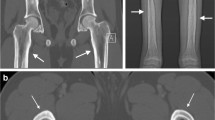Abstract.
Though growth hormone stimulates markers of bone formation in adults, its in vivo effect on osteoblasts is unknown. We have used histomorphometry of fluorochrome-labeled iliac crest biopsies along with biochemical markers to assess bone formation and resorption rates before and after treatment with growth hormone (Genotropin; 3.0 IU/day for 6 months) in combination with calcitonin (Miacalcin nasal: 200 IU daily) in a man with osteonecrosis and decreased spinal bone mineral density (BMD). Treatment resulted in increases in indices of bone formation and a marked increase in osteoblast number and osteoid surface, with a concomitant decrease in the number and size of marrow adipocytes. There was no change in spinal or total BMD. These data confirm the stimulatory effect of growth hormone on the osteoblast population and suggest that this may occur by the commitment of early precursor cells to the osteoblastic as opposed to the adipocytic lineage.
Similar content being viewed by others
Author information
Authors and Affiliations
Additional information
Received: 14 June 1996/Accepted: 22 November 1996
Rights and permissions
About this article
Cite this article
Kröger, H., Soppi, E. & Loveridge, N. Growth Hormone, Osteoblasts, and Marrow Adipocytes: A Case Report. Calcif Tissue Int 61, 33–35 (1997). https://doi.org/10.1007/s002239900289
Published:
Issue Date:
DOI: https://doi.org/10.1007/s002239900289




